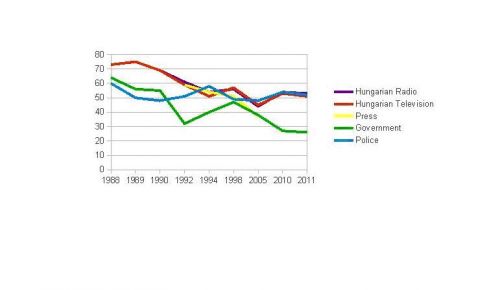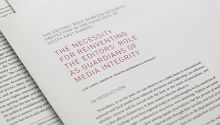Flash Report: Hungary
 A series of interviews conducted with journalists revealed that there is a tendency of censorship and self-censorship in the public service media and in the media in general.
A series of interviews conducted with journalists revealed that there is a tendency of censorship and self-censorship in the public service media and in the media in general.

The Government Overtakes Public Service Media.
Unusually late, on March 14, 2013 a heavy snowfall and wind arrived to Hungary. The two combined caused snowdrifts and hundreds of motorists were stuck on the motorway and other roads in the North-Eastern part of the country. The roads were covered with snow and ice, huge traffic jams formed making further movement impossible. Those hundreds, who needed to spend the night in their cars were listening the main public service radio station in vein, as it was not broadcasting news related to the snow situation, like which roads might mean an escape out of the snow trap or what people should do under the extreme circumstances. Realizing how important it was to inform the trapped people – among others – a local radio station started broadcasting and a Facebook page was distributing information about where to seek help and what to do when the level of petrol is becoming dangerously low. Many were dissatisfied with the performance of the public service broadcaster. (1)
The public service broadcaster has not really enjoyed the trust of the public. Since the democratic transition the level of trust has deteriorated, in 2011, the combined level of trust of the Hungarian Television (Magyar Televízió, MTV) and Hungarian Radio (Magyar Rádió, MR) were at 52 points out of 100. (Note that when data is available, it is visible that the level of trust in the press in general was decreasing too.)
Levels of trust in various public institutions, 1988–2011
Source: Tibor Závezc, Ipsos (2)
The licence fee was abolished in 2002, since then the public service broadcasters have received funds directly from the parliament, or rather the parliamentary majority of the day. The news bulletin of the national television channel has always been considered to be biased to a greater or lesser extent to the incumbent governing party. This impression has been further influenced by the fact that after every election when the former ruling party lost and a new government was formed, editors, news anchors and other emblematic figures of the public service broadcaster resigned or were fired. (3)
Appearance of members of governing coalition and its parties/parliamentary opposition parties in the news bulletins of MR and MTV
Source: ORTT and NMHH (4)
Generally, the public service broadcaster's news bulletins provide more airtime for the governing parties than to the opposition parties. After the 2010 legislative elections, when the conservative Fidesz – Hungarian Civic Union (Fiatal Demokraták Szövetsége – Magyar Polgári Szövetség, Fidesz) party together with the Christian Democratic People's Party (Kerszténydemokrata Néppárt, KDNP) gained a two-thirds parliamentary majority, the difference between the governing parties and the opposition parties has increased – reflecting their parliamentary power and even exceeding the two-thirds/one-third ratio. In practice, these ratios mean that members of the opposition parties are cited or paraphrased mainly by the news anchor only, while members of the governing party are cut in the news bulletins, as they speak.
The audience share of all channels of the public service broadcaster (M1, M2 and Duna TV) have been traditionally low. Meanwhile the audience shares of national commercial television channels (RTL Klub and TV2) have been shrinking, too.
Share of national television channels, total population, whole day
Source: ORTT and NMHH (5)
In 2008, M1 and M2 have started to broadcast their programmes in high definition (HD), including sports games, like the Olympic Games and popular football matches. Still, in 2009, the combined audience share of the public service broadcaster television channels (13.6) (6) was one of the lowest in comparison with the average of the European Union member countries (30.2) and as the data indicates above, the low audience share has not changed much since then.
After the 2010 parliamentary elections, a new media regulation was drafted and accepted by the governing majority, without any meaningful public consultation with the opposition or stakeholders. The media law package has triggered wide domestic and international criticism. It has been amended several times, partly due to the pressure imposed by the European Commission (7). Despite the amendments, the Hungarian media regulation is still subject to criticism for several reasons, which include that the Media Council, the main decision-making body of the National Media and Infocommunications Authority's (NMHH) is a one-party body, as its members have been nominated by the governing party only; the Media Council can impose high fines on all types of media outlets for infringing the stipulations of the media regulation – including the ones redacted in a way that they can be interpreted several ways; and the media regulation has been amended frequently, which creates uncertainty.
The decisions of the Media Council somewhat reflect the critical concerns. The Standards Media Monitor assessed that during the 2011 radio-frequency allocation process the decision-making body's preference towards three government-friendly operators became apparent (8). Partly for this reason, Freedom House downgraded the country's press freedom index to 'partly free' for its 2012 report (9).
In 2010, as part of the new media regulation, the complete overhaul of the public service broadcasting system was launched. The assets and most of the employees of the three public service broadcasters (Hungarian Television, Duna Television and Hungarian Radio) and the Hungarian Wireless Agency (MTI) were united under the Media Service Funding and Asset Management Fund (MTVA), which is dependent upon the NMHH, which is dependent upon the Media Council. The public service broadcasters order programmes from MTVA, while the news bulletins of all television channels and radio stations are produced exclusively by MTI. Former head of MTI, Csaba Belénessy said in an interview in 2010 that “a public service media outlet has to be loyal to the government and fair to the opposition.” (10)
During the overhaul of the public service media, journalists, editors and other professionals were dismissed. Meanwhile some mistakes were made in evening news bulletins of MTV, like not showing the protesters in MTV in January 2012 (11), the blurring of the former head of the Supreme Court – which case triggered the hunger strike of former public service journalists (12), or the manipulation of an interview with MEP Daniel Cohn-Bendit in December 2011. (13)
A series of interviews conducted with journalists revealed that there is a tendency of censorship and self-censorship in the public service media and in the media in general. An anonymous employee of the public service television said: “The morning meeting made it obvious what the message of the day, what the overall concept was supposed to be, and we had to shoot the reports with that in mind.” (14)
The overhaul of the public service system also brought that MTI is providing almost all of its news items for free for everyone creating a virtual monopoly and serving media outlets lacking resources to send reporters to the venue of an event. Some of these media outlets simply copy+paste the news produced by MTI creating a rather uniform news offer on the market.
Scattered data available indicate that the public service media tends to order programmes and/or advertising from companies close to the incumbent government. This was the case both under the Socialist government back in the 1990s and the current Conservative government. (15)
According to the Amsterdam Protocol “the system of public broadcasting in the Member States is directly related to the democratic, social and cultural needs of each society and to the need to preserve media pluarlism.” (16) The Hungarian public service media currently cannot meet at least two of these criteria. Firstly, the fact that the most of the news of MTI are distributed for free does not promote media pluralism, especially in these economic crisis-stricken times. Secondly, the democratic needs of the Hungarian society are not satisfied, as the public service media has mostly been used for political purposes to a greater or a lesser extent, as it is subject to the financial decisions of the parliamentary majority of the day and as to some degree its news bulletins have tended to be biased towards the government of the day. Being depedent on the political elite, the Hungarian public service broadcasting will always fail to consolidate in terms of the transformation from state and government controlled radio and television into public service outlets.
Notes
(1) Nevertheless, in June 2013, when the river Danube flooded and reached record levels the public service radio launched a separate radio station titled Flood FM on the abandoned frequency of a national commercial broadcaster distributing news about the flood situation along the river.
(2) Tibor Závecz, the opinion research director of Ipsos, presentation “Médiapresztízs—társadalmi bizalom” (Media prestige—public trust) at a conference on “A magyar közmédia küldetése és lehetőségei” (The mission and possibilities of the Hungarian public media), June 16, 2011, Budapest; Tibor Závecz, presentation “Mennyire bízunk a médiában?” (How much do we trust the media?), Goethe Institute, Budapest, February 29, 2012.
(3) Borbala Toth, Mapping Digital Media: Hungary, Open Society Foundations, Eds. Marius Dragomir et al., January 2012, p. 38.
(4) National Radio and Television Commission (Országos Rádió és Televízió Testület, ORTT, Beszámoló az Országos Rádió és Televízió Testület 2006-os tevékenységéről (Report on the activity onf National Radio and Television Commission) of 2006 (p. 417–420), 2007 (p. 442–445), 2008 (p. 542–545), 2009 (p. 116–119), 2010 (p. 99–100); National Media and Infocommunications Authority (Nemzeti Média- és Hírközlési Hatóság, NMHH), Beszámoló a Nemzeti Média- és Hírközlési Hatóság Médiatanácsa 2011-es tevékenységéről, Report on the activity of the National Media and Infocommunications Authority's Media Council in 2011 (p. 58–60), 2012 (p. 78–82).
(5) National Radio and Television Commission (Országos Rádió és Televízió Testület, ORTT, Beszámoló az Országos Rádió és Televízió Testület 2009-es tevékenységéről (Report on the activity onf National Radio and Television Commission) of 2009 (p. 576), 2010 (p. 394); National Media and Infocommunications Authority (Nemzeti Média- és Hírközlési Hatóság, NMHH), Beszámoló a Nemzeti Média- és Hírközlési Hatóság Médiatanácsa 2012-es tevékenységéről, Report on the activity of the National Media and Infocommunications Authority's Media Council in 2012 (p. 281).
(6) Peter Bajomi-Lazar., Vaclav Stetka and Miklós Sükösd, Public Service Television in European Union Countries: Old Issues, New Challenges in the 'East' and the 'West', pp. 355–380, In: Trends in Communication Policy Research: New Theories, Methods and Subjects, Eds. Natascha Just and Manuel Puppis, Intellect Bristol, UK, p. 364.
(7) For a concise chronology of the Hungarian media regulation please refer to the website of Center for Media & Communication Studies, Hungarian Media Law, https://cmcs.ceu.hu/resources-new-media-laws-in-hungary-0.
(8) Standards Media Monitor, “The Media Council's tender procedures for broadcasting frequencies”
(9) Freedom House, Hungary, Freedom of the Press 2012.
(10) Ágnes Lampé, “Kormányfelügyelet a médián: 'Most tesszük le a magyar BBC alapjait'” (Government control over the media: “We are laying the foundations of the Hungarian BBC”), 168 óra, December 13, 2010.
(11) “To the margins of an early January protest in Hungary”, January 8, 2012, The Contrarian Hungarian
(12) “Pres freedom in Hungary: Journalists protest manipulation with hunger strike, December 16, 2011, Spiegel.de.
(13) “How the news gets edited on Hungarian State Television,” December 14, 2011, The Contrarian Hungarian.
(14) Attila Mong, “The Reins on Freedom: Self-Censorship in the Hungarian Press”. The article was originally published in Hungarian in Élet és Irodalom, LVI, Nr. 15, April 20, 2012.
(15) Péter Bajomi-Lázár, The Party Colonisation of the Media. The Case of Hungary, In: East European Politics and Societies and Cultures, Vol. 27, Nr. 1, February 2013, Pp. 69–89. P. 80, 83.
(16) Treaty of Amsterdam Amending the Treaty on European Union, The Treaties Establishing The European Communities and Related Acts, Official Journal C 340, 10 November 1997.


